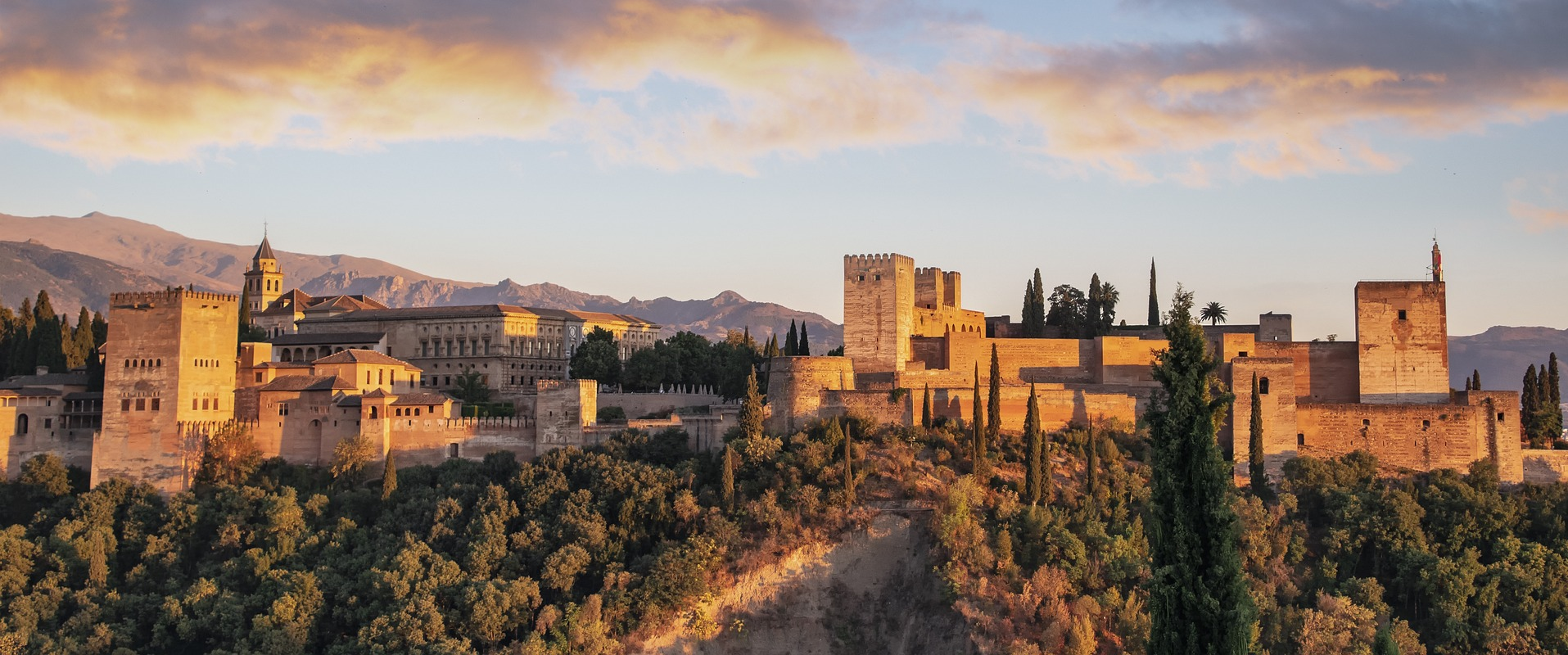
The Glorious History of the Alhambra in Granada
The Alhambra in Granada, Spain, is one of the most impressive and iconic monuments in the world. Built on a hill overlooking the city, this majestic fortress has defied centuries of history, art and architecture. On this page, we will explore the rich history of the Alhambra, from its origins as a military fortress to a masterpiece of Moorish and Islamic art, and finally its transformation into a symbol of Spanish and European culture.
The Moorish Origins
The story of the Alhambra begins in the 9th century, when the Iberian peninsula was invaded by Muslim Moorish troops. In 711 AD, the city of Granada was taken by the Moorish ruler Tariq ibn Ziyad. Under Moorish rule, construction of the Alhambra began as a modest fortress on the hill of Al-Sabika, with the aim of defending the city from outside attacks.
The origin of the name “Alhambra” is somewhat controversial, but many believe it derives from the Arabic word “Al-Hamra,” meaning “the red one”, due to the red colour of the walls of the fortress. During the following centuries, the complex expanded steadily, and it later became the royal residence of the Nasrid dynasty, which ruled Granada from the 13th to the 15th century.
The Golden Age of the Alhambra
The 13th century is considered the golden age of the Alhambra. Under the reign of Mohammed I, Moorish architects and artists began transforming the fortress into a palace of unprecedented beauty. The Nasrid dynasty commissioned the construction of magnificent halls, courtyards and gardens within the complex, and introduced intricate stucco decorations and Moorish tile art.
One of the most striking features of the Alhambra is the Nasrid Palace. This palace houses some of the most stunning architectural features, including the famous Patio de los Leones, or “Court of the Lions,” with its central fountain surrounded by twelve marble lion statues. Other highlights include the Sala de los Abencerrajes, the Sala de los Reyes and the Sala de las Dos Hermanas.
The End of Moorish Rule
However, the Nasrid dynasty and their rule over the Alhambra came to a tragic end. In 1492, Catholic kings Ferdinand and Isabella conquered Granada, leading to the end of Muslim rule in Spain and the beginning of the Catholic reconquista. The Alhambra came under Christian control, and the Nasrid Palace was renamed the Royal Palace of Granada.
The Renaissance and the Redesign
With the advent of the Renaissance in Europe, the Alhambra underwent further changes. The Christian kings, notably Charles V, decided to build a Renaissance palace within the complex, which was a sharp contrast to the Moorish architecture. Now known as the Palace of Charles V, this palace is a notable example of Renaissance architecture in Spain.
In addition, many of the Moorish decorations and artworks were removed or damaged during this period. Some rooms were converted into Catholic chapels. Despite these changes, parts of the Moorish heritage were preserved in the Alhambra. The complex remained an important cultural and historical site in Spain.
Neglect and rediscovery
In the following centuries, the Alhambra fell into disrepair and was largely neglected. During the French occupation in the early 19th century, parts of the complex were damaged by Napoleon’s troops. It was not until the 19th century that there was renewed interest in preserving and restoring the Alhambra.
Spanish writer and politician Washington Irving played an important role in rediscovering the Alhambra for the Western world. In 1832, he published “Tales of the Alhambra,” a series of stories and essays describing the splendour and history of the Alhambra. His work contributed to the growing fascination with the Alhambra and its appeal to artists, writers and travellers.
The Alhambra as a National Monument
In the 19th century, the Spanish government began restoring and preserving the Alhambra. This resulted in the 1870 Alhambra Decree, which officially declared the complex a national monument and established measures to ensure its preservation and protection.
One of the key figures in these restoration efforts was the architect Rafael Contreras. He dedicated himself to restoring the Alhambra’s Moorish beauty and architecture. Many of the restorations carried out under his direction helped restore the complex to its former glory.
The Alhambra today
Today, the Alhambra is one of the most visited tourist destinations in Spain and a UNESCO World Heritage Site. Every year, millions of tourists from all over the world flock to Granada to experience this magnificent monument. The complex consists of several parts, including the Nasrid Palace, the Generalife, the Palace of Charles V and the Alcazaba, each with its own unique charm and history.
The Nasrid Palace remains a highlight, with its elaborate stucco decorations, Moorish tiles, and beautiful courtyards. The Generalife, once the royal gardens of the Alhambra, offers a stunning array of gardens, fountains and terraces with stunning views of the city of Granada and the surrounding mountains.
The Alhambra is not only a paragon of architectural splendour. It is also a cultural symbol of the centuries of history and influences that have shaped Spain. It combines Moorish, Islamic, Renaissance and Christian elements in a magnificent fusion of cultures. If you ever have the chance to visit the Alhambra, you will be amazed by its timeless beauty and the history contained within.